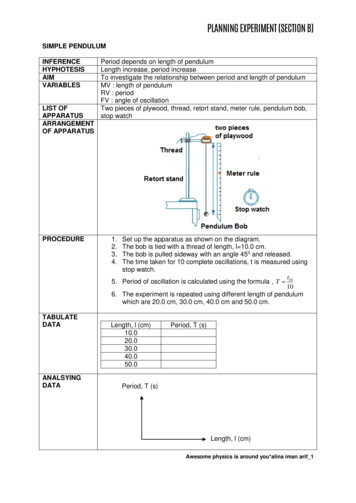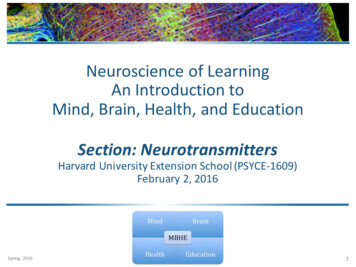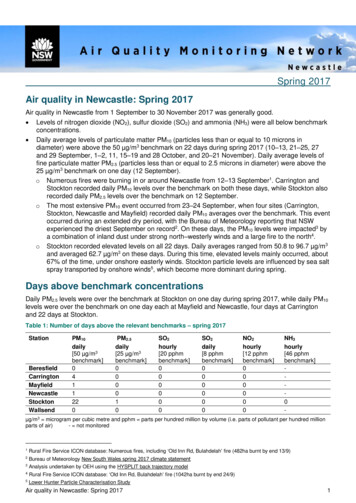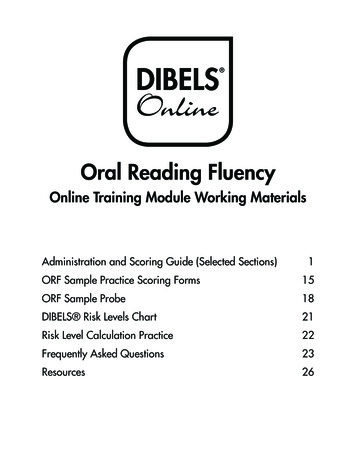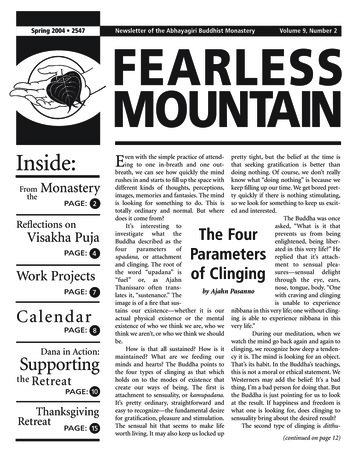
Transcription
Spring 2004 2547Newsletter of the Abhayagiri Buddhist MonasteryVolume 9, Number 2FEARLESSMOUNTAINInside:FromtheMonasteryPAGE: 2Reflections onVisakha PujaPAGE: 4Work ProjectsPAGE: 7CalendarPAGE: 8Dana in Action:Supportingthe RetreatPAGE: 10ThanksgivingRetreat PAGE: 15ven with the simple practice of attend- pretty tight, but the belief at the time ising to one in-breath and one out- that seeking gratification is better thanbreath, we can see how quickly the mind doing nothing. Of course, we don’t reallyrushes in and starts to fill up the space with know what “doing nothing” is because wedifferent kinds of thoughts, perceptions, keep filling up our time. We get bored pretimages, memories and fantasies. The mind ty quickly if there is nothing stimulating,is looking for something to do. This is so we look for something to keep us excittotally ordinary and normal. But where ed and interested.does it come from?The Buddha was onceIt’s interesting toasked, “What is it thatinvestigate what theprevents us from beingBuddha described as theenlightened, being liberfourparametersofated in this very life?” Heupadana, or attachmentreplied that it’s attachand clinging. The root ofment to sensual pleathe word “upadana” issures—sensual delight“fuel” or, as Ajahnthrough the eye, ears,Thanissaro often transnose, tongue, body. “Oneby Ajahn Pasannolates it, “sustenance.” Thewith craving and clingingimage is of a fire that susis unable to experiencetains our existence—whether it is our nibbana in this very life; one without clingactual physical existence or the mental ing is able to experience nibbana in thisexistence of who we think we are, who we very life.”think we aren’t, or who we think we shouldDuring our meditation, when webe.watch the mind go back again and again toHow is that all sustained? How is it clinging, we recognize how deep a tendenmaintained? What are we feeding our cy it is. The mind is looking for an object.minds and hearts? The Buddha points to That’s its habit. In the Buddha’s teachings,the four types of clinging as that which this is not a moral or ethical statement. Weholds on to the modes of existence that Westerners may add the belief: It’s a badcreate our ways of being. The first is thing, I’m a bad person for doing that. Butattachment to sensuality, or kamupadana. the Buddha is just pointing for us to lookIt’s pretty ordinary, straightforward and at the result. If happiness and freedom iseasy to recognize—the fundamental desire what one is looking for, does clinging tofor gratification, pleasure and stimulation. sensuality bring about the desired result?The sensual hit that seems to make lifeThe second type of clinging is ditthuworth living. It may also keep us locked up(continued on page 12)EThe FourParametersof Clinging
Monastery photoFROM THE MONASTERYAjahn Prateep pays respects to a snowy Buddharupan late December, after a full month of teachings and events,Ajahn Pasanno returned from Thailand. The community wasvery happy to see him back, and also to welcome Ajahn Prateep,who traveled with Ajahn Pasanno. Ajahn Prateep has spent thelast twelve years as a monk, living in Ajahn Chah branchmonasteries in Thailand. He spent several years training withAjahn Dtun, and most recently spent two years at WatNanachat, helping to oversee various construction projects.Ajahn Prateep last visited the U.S. fifteen years ago when training as an airplane mechanic. He has been interested for sometime in supporting the growth of the Western Sangha in thislineage. His English is quite good and is steadily improving. Justa few days after he arrived, the only snowfall of the winter blanketed Abhayagiri; this was heartily enjoyed by Ajahn Prateep, asit had been fifteen years since he last saw snow! As a celebratory gesture, he removed many layers of warm sweaters andfleece, and with only his angsa (shoulder cloth), bowed in thesnow to the Buddha statue on the hillside above the Dhammahall. Fortunately, some pictures were taken before he bundledup again. Ajahn Prateep has settled in very smoothly to community life at the monastery, and we are delighted to haveanother ajahn to learn from and practice with.The community entered their annual winter retreat onJanuary 4, the same day that Anagarika Craig took noviceordination and became Samanera Ahimsako, “one who is gentle to all beings.” Ahimsako’s mother, brother and brother’sfamily joined us for the ceremony. By then, the retreat supportcrew had all filtered in and got themselves settled, and everything got underway very smoothly. There were three returnersfrom last year—Ginger, Kristin and Brian—and two firsttimers—Cindy and Manu (see page 10). Their eagerness,I2Fearless Mountaincompetence and generous attitude in taking over the runningof the monastery were much appreciated. Generally, ourthree-month retreat was structured in two-week segments,between the full and new moons. The retreat began on a fullgroup practice schedule, with morning and evening pujas,morning Dhamma readings and group practice, and afternoon group practice. The Ajahns decided to begin the retreatby reading from Food for the Heart, an anthology of AjahnChah’s Dhamma talks. These readings were appreciated by all;Ajahn Chah’s direct, profound and practical Dhamma set anexcellent tone for the beginning of the retreat.The last C.A.L.M. (Community of Abhayagiri LayMinisters) gathering at Abhayagiri happened in January.Members of the ongoing three-year plus training traveledfrom far and wide, including Florida, Wisconsin, Oregon,Massachusetts and Canada, and stayed at Dennis Crean’shome just a few minutes from the monastery. There was a palpable sense of joy and community, as the group delights in thestudy and spreading of Dhamma. The final session will beheld in Cape Cod in April.After the first fortnight, the retreat schedule began toshift: sometimes there was group practice in the morning andindividual time in the afternoon, sometimes vice versa, andsometimes no group practice at all so that everyone couldspend most of the day in seclusion in the forest. Every twoweeks, the ajahns would change the schedule around to helpus develop more resilience in practice—so we wouldn’t gettoo complacent with any one mode of practice and lest any ofus had forgotten about impermanence.After finishing Food for the Heart, Ajahn Amaro moved onto an as-yet unpublished collection of Ajahn Sumedho’srecent Dhamma talks, which had a profound yet refreshinglysimple tone and message. After Ajahn Sumedho’s teachings,we moved on to Being Dharma, a slightly older anthology ofAjahn Chah’s teachings, translated by Paul Breiter, and then tothe manuscript of a forthcoming companion volume to BeingDharma. Hearing these teachings read aloud by our ajahnsduring a period of intensive practice was very inspiring andmuch appreciated. Throughout all the readings, both ajahnsoften added their comments, elucidating salient aspects of theteachings and telling us stories to help us understand. Thenext readings were from A Still Forest Pool, the first anthologyof Ajahn Chah’s talks published in the West and edited by PaulBreiter and Jack Kornfield.In accordance with the tradition dating back to the timeof the Buddha, every fortnight the resident monastics atAbhayagiri take part in the Uposatha ceremony, when theyrenew their vows (precepts) and confess any transgressions.One monk will chant the Patimokkha, the actual Pali recitation of the monastic discipline. In ancient times, monastics
Bangkok. Her very direct, uncompromising instructions arelucid and precise.The community will miss Ajahn Amaro, who departed onApril 6 for several teaching engagements, and then for hisyear-long sabbatical. After stops in New York andMassachusetts, he will fly to England to plant a tree atChithurst Monastery in honor of his mother. He will lead a10-day retreat at Amaravati Buddhist Monestary, a weekendretreat at Gaia House, and join his sister for her 50th birthday.He is planning to depart for India in late May. Ajahn Amarohas not had a substantial break of “unstructured time” from“being Ajahn Amaro,” his co-abbotship and considerableteaching schedule, since Abhayagiri opened in 1996. He says,“I intend to be just another anonymous dust-collecting wanderer in India,” smiling with glee. Although the communitywill miss him during his travels, we also share his joy to beable to take some time away to practice and wander.The community is expecting to welcome Tan Sudantoand Tan Karunadhammo back in late April. Tan Sudantospent the winter at Birken Forest Monastery in BritishColumbia with Ajahn Sona and his community and will bereturning via Portland, where he will visit family and theFriends of the Dhamma meditation group led by Sakula(Mary Reinard). Tan Karunadhammo has been away since lastJune, when he left for the Bodhiyanarama Monastery in NewZealand. From there, he spent some time at BodhivanaMonastery in Australia. He returned to the U.S. in February tovisit family and to spend some time at the Bhavana Society inWest Virginia.As the retreat draws to a close, there is a great sense ofgratitude and appreciation both for the support crew of theretreat and for all the other supporters of the monastery whomake this way of life possible.—Anagarika Adam, for the SanghaMonastery photodwelling in an area would gather on the full moon and newmoon for this ceremony, which was an important part ofkeeping the tradition alive, as no discourses or rules werewritten down for several hundred years after the Buddha’sparinibbana. The Patimokkha is approximately 13,000 wordsand takes roughly 45 minutes to recite. It is no small feat tomemorize and recite this, and the community congratulatesthe efforts of Tan Ñaniko, who chanted the Patimokkka forthe first time during the winter retreat.On March 5, the full moon night, the community celebrated Magha Puja, the anniversary of a spontaneous gathering of 1,250 Arahants, who came to pay respects to theBuddha and hear his words early in his teaching career. TheBuddha gave the often quoted, concise teaching known as theOvadapatimokkha:Refraining from all harmful acts,Performing what is truly good,Purifying the heart,This is the teaching of all the Buddhas.After evening chanting, meditation and a Dhamma talk byAjahn Amaro, the community, along with about thirty visitors, took part in an ancient Buddhist tradition, making threecircumambulations of the Dhamma hall with flowers, candlesand incense. The first round was dedicated to contemplatingthe qualities of the Buddha, the second was in honor of theDhamma, and the third was for the Sangha. A shrine was setup on the base of the steps, and the silent candlelit processionunder the brilliant full moon was a very evocative scene,bringing up a sense of the timelessness of the Buddha’s teachings and the faith and devotion that modern day practitionersstill feel, twenty-five centuries later. After the circumambulations, the community and a few visitors continued with theirregular weekly vigil, meditating through the night untilmorning chanting at 3:00 a.m.During the second to last fortnight of the retreat, thecommunity engaged in a full group schedule again, practicingsitting and walking meditation together from early morningto late at night in the Dhamma hall. The ajahns read fromVenerable Father, a memoir by Paul Breiter of his time andrelationship with Ajahn Chah. Paul’s depictions of life at WatPah Pong in the early seventies were delightful and helped usdevelop a sense of the origins of many of the modes of practice and training that are carried on today. Also, Paul’s sense ofhumor and numerous experiences with Ajahn Chah’s fiercetraining were greatly enjoyed. The depth of Ajahn Chah’s careand compassion for his disciples came through the storiesclearly and was very touching. The final reading was from arecent translation of Dhamma talks by Upasika Kee Nanayon,a highly respected lay Dhamma teacher who founded awomen’s meditation community in the countryside nearThe new ordination platform and pavilionSpring 20043
Gathering Together theThree Levels of Truthby Ajahn Amarorom my experience, I see three levels of truththat can be found in all spiritual traditions.The first is the level of history or “what actuallyhappened.” The second is the level of myth. Thethird is how the first two layers map on to ourown psyche and experience. These three areinterwoven in all religions.Using the example of the Christian orHebrew Bible, one can see that for the past 150years, academics have been going through thetext questioning its authenticity and validity.This is a bit like a little kid dissecting a slug to seehow it works and then becoming upset that theslug can no longer move around or eat lettuce.The dissection of religion takes away its truemeaning. Does Cinderella become a useless storybecause there might not have been an actualyoung woman named Cinderella? No. It’s a greatstory! And why do we keep telling it? Because it isuseful. Any of the thousands and thousands oftales repeated around living rooms and campfires are told because they are good stories. Theyconvey meaning that is useful to us.Among these is the story of the Buddha’s life.About 2,500 years ago in a Nepalese kingdom, amale child was born and for various reasons leftthe life of privilege and comfort in a royal household to become a wandering mendicant.Somewhere along the line, he had a profoundexperience of insight and then proceeded for therest of his life to wander as a yogi living on whatever was offered from the benevolence of thelocal people. In exchange, he would teach thosewho invited him to share what he had to say.After eighty years, he passed away, having founded a religious order of both women and men.Most historians would agree that something likethis happened.On the mythological level, events happenedin a much more glorious and miraculous way.The Buddha’s birth on the full moon of Mayoccurred in an environment of earthquakes,rainbows and celestial music. His mother gavebirth to him standing up. He walked and talkedas soon as he was born. His birth had been predicted to be that of an amazing person: either aworld conqueror or the greatest sage to walk theplanet. Since his father, the king, wanted his sonFWith the comingof the Buddhistfestival day ofVisakha Puja,celebrated thisyear on June 2,Ajahn Amaro andAjahn Pasannoreflect on thisanniversary of theBuddha’s birth,enlightenment,and death.4Fearless Mountainto end up as a world conqueror, he made sure tokeep out of sight anything that would cause hischild to incline towards the religious life. The old,sick and deceased were hidden from him. Ofcourse, the prince eventually left the palace andsaw these forbidden sights, along with that of awandering mendicant showing him the path hewould soon embark upon himself.There are many wonderful and marvelousevents in the Buddha’s historical and mythological lives. But the Buddha himself said that themost wonderful and marvelous quality was thatwhen a feeling arises in the mind of theTathagata, he knows this is a feeling arising.When a feeling abides in the mind of theTathagata, he knows this is a feeling abiding.When a feeling fades away in the mind of theTathagata, he knows this is a feeling fading away.So too with thoughts and perceptions.So why then are the Buddha’s birth, death andenlightenment brought together on one day? Myown theory is that this points to the very practiceof meditation itself for perhaps there is something in our experience of the moment that gathers together in a similar way, that follows the samepattern on an internal and much-diminishedscale. For example, we notice a sensation in ourbody: our knee starts to ache. This is equivalent to“the life of the Bodhisattva” before the enlightenment: a sensation arises; it is born. There is a bitof happiness and a bit of pain. Then the pain inour knee no longer comes and goes but begins todominate our perceptions—“This hurts”—andwe struggle with it. This is comparable to theBuddha becoming dissatisfied with life in thepalace: it is tedious, boring and burdensome.Perhaps then we remember some spiritualinstruction. In the life of the Buddha, this is theripening of spiritual virtues, or paramitas. Whenhe saw sickness, old age and death, followed bythe religious seeker, those virtues ripened, and hesaid, “Ah ha, that’s the way!” In our own microcosm, we remember that we are supposed to bepaying attention to the pain in our knee, not justsitting there wrestling with it, hating it, fearing it,resenting it. Perhaps we have imagined it is bonecancer or a ripped cartilage. “Wait a minute,” wethink. “ I should be working with this instead ofgetting carried away!” So that’s the Buddha waking up to the problem of pain and seeking to dosomething about it.(continued on page 6)
An Extraordinary YetOrdinary Human Beingby Ajahn Pasannoisakha Puja is the commemoration of theBuddha’s birth, enlightenment and passingaway. It is the most important festival in theBuddhist calendar. In Thailand, this day is different from other Buddhist festivals in that, whilemany can become occasions for drinking, feasting and big parties, Visakha Puja has retained aquality of recollection and spiritual aspiration.The birth, enlightenment and death of theBuddha all took place on the full moon in May.It’s a good reflection to see these events as inextricably linked. Birth can be seen as the cominginto being of the quest for enlightenment. Then,there is the enlightenment itself. Finally, whenthe physical body dies, does the enlightenmentprinciple die with it? Not really. The whole pointof the Buddha’s life was the realization of thedeathless. That is, there is something beyondbirth, sickness and death, something beyondchange and separation. The Buddha asked thequestion: “Why do I, being subject to old age,change and separation, seek after that which isalways subject to old age, change and separation?” This is a question in all of our lives.The general plight of people in the world isbound by ignorance and obstructed by craving,creating a vortex of forces in the unenlightenedhuman mind. The aspiration of the Buddha’s lifeis to seek that which is unbound and unobstructed. His enlightenment is a continual, ongoingexample that this is possible.The Buddha named his son Rahula, meaning“fetter.” The birth of his son was something thatwas binding. When one hears the word “fetter,”one might believe the name was chosen throughaversion, nastiness or pettiness. Instead, it was thedeep love that the Buddha felt towards his son thatled him to realize that even this kind of love needsto be transcended, needs to be gone beyond.The Buddha’s quest for enlightenment wasinextricably bound to love and compassion forothers. He realized that if he himself were boundby attachment, then the whole human race mustbe bound in the same way. So how do we workwith qualities of love and attachment? How dowe deal with aversion and irritation? These arethe circumstances and difficulties that theBuddha himself worked with, dealt with andVunderstood—even the ordinary squabbles andpetty jealousies that can take root in a community and grow into great conflicts.The qualities of compassion and lovingkindness were manifested in the Buddha’s ownrenunciation, his own relinquishing of comfortand worldly success to seek liberation. Spiritualseeking is itself an act of compassion. Often,when we think of renouncing or giving up something, of having to desist from a passion withwhich we identify strongly, there is a feeling ofloss, fear or insecurity. Actually, letting go is anact of compassion and kindness that includeseveryone. Letting go can be to our attachment toprecepts or meditation as well as to our obsessivethoughts. Often, the mind balks at renunciationand tries to fill itself up with other things. Whenone lifts the mind to a recollection of the benefitsof relinquishment, one can draw on compassionand kindness. One is fortified for going thoughthe wavering of the mind and turning towardsthat unbinding and unobstructed quality. This iswhat the Buddha’s teaching is about.There is a lovely image in the suttas wherethe Buddha was quite old and recovering from anillness. He was still weak but managed to get outside to warm his limbs in the afternoon sun.Ananda came along and said, “I’m so glad to seeyou are getting better. I was worried about yourhealth. I was afraid you were going to pass away.”Ananda sat beside the Buddha massaging hisback and limbs, commenting on how marvelousand strange it is that the Buddha’s formerly firm,strong and glowing body was now old, wrinkledand losing its luster. The Buddha replied, “Yes,this is very ordinary. This is the way it is.” Hisbody was like a drum that had been patchedagain and again over the years. After a while,some of its original parts were simply not thereany longer.We should look at the Buddha as a humanbeing. He was not a mythological figure or a god.One reason many of us were attracted to AjahnChah as our own teacher was his very humanness.I remember a story of Ajahn Chah from when hetaught at the Insight Meditation Society in 1979.Ajahn Chah had been at IMS for many days, andpeople felt uplifted by his presence and teachings.He was a very inspiring and charismatic figure.One day after the meditation as he got up andwalked slowly out of the meditation hall, heturned to the group and said, “My knees hurt.”(continued on page 6)“One uses one’scircumstances forunderstandingoneself. That’s thesame thing as theaspiration forfreedom.”Spring 20045
Ajahn Amaro Takes a Sabbaticaln April 5th, in a small ceremony that brought smiles,laughs, and a few twinges of hearts, Ajahn Pasanno andthe rest of the community have given Ajahn Amaro theirblessing to begin a year’s sabbatical.After nearly eight years of tireless work in helping establish Abhayagiri as a monastery, training ground, communityresource and general embodiment of the Triple Gem, it’s timefor Ajahn Amaro to be allowed some time to focus on his ownpractice. This is a wonderful sign of confidence in the monksleft in the monastery, a rare treat for a tireless teacher, and asound investment in the future of our community.After a few spring teaching engagements, Ajahn Amarowill begin a period of further refining the heart of generosity,wisdom, patience and energy that has been a guiding light tomany of us over the years. In true forest monk style he haschosen to go wandering. Together with two upasakas, he plansto spend an unplanned year on pilgrimage in India visitingthe Holy sites of the Buddha and will be unreachable over theentire period.Ajahn Amaro commented that between his very body,built up from the alms of the faithful, and his requisites,which have been given to him and attended to by so many, hewill be daily reminded of the importance of Sangha.Leaving behind much of what we consider to be “AjahnAmaro,” he will instead be just another bhikkhu following inthe footsteps of the Buddha, striving for the goal for whichyoung men from good families rightly go forth.Sadhu Ajahn! We wish him very well, and look forward tosharing in the benefits on his planned return in June 2005.—Hasapañño BhikkhuThree Levels of Truth (continued from page 4)Extraordinary Yet Ordinary (continued from page 5)“All right,” we may say, “this is a pain in my leg. I shouldget rid of the pain by suppressing it and paying attention to thebreath instead.” This is what the Buddha did in the beginning.He used his will to drive out all that was unwanted in his mind,such as fear, thoughts and emotions. Six years of suppressionleft the Buddha in a barren, intense and collapsed state.Then in our meditation we remember the Middle Way.Suppression is motivated by fear and hatred—the thought “ Iwant to get rid of it.” Instead, we should make friends with thepain. It is just a feeling. All feelings arise and pass away. Justrelax. This is the moment of “enlightenment.” The heartreleases. The feeling of pain is still there, but we let go of thetension around it, let go of the fear, let go of negotiating. It justis what it is. In that moment we share the life of the Buddha.The feeling in the leg may persist—it may get a bit stronger,disappear, come back, change and move around—but it’s nolonger a problem.Eventually the pain goes away or the bell rings for the endof the meditation. This is the “Parinibbana,” the finalNibbana, the passing of the Buddha. The object disappears.Even with just a thought or a sound, there is a natural qualityof pure bliss with its cessation. When the chirping of birds orthe hum of the refrigerator stops, there is a feeling of relief.This is a micro- or nano-parinibbana. When the conditionceases, we experience the bliss of the free mind. That bliss,clarity and peacefulness has been there all along, but it wasobscured by the experience of grabbing the feeling, the hope,the fear or the excitement. The pattern of the entire life of theBuddha thus charts the process of our experience, if the heartis guided wisely, as it manifests in a few seconds of meditation.The birth, enlightenment and Parinibbana celebrated atVisakha Puja gather together in this way as a symbol of this pathof insight and true knowing that leads to the heart’s release.People often think, “Ah, here is a great spiritual master. Heprobably doesn’t experience any pain, his feelings are not likemine.” That’s not true. Our aspiration is not to be rid of feelings. We should not think that if we didn’t have certain feelingsor if we had other feelings, then we could become enlightened.Instead, the path to enlightenment is to pay attention to theordinary qualities of our likes and dislikes, our loves andattachments. How do these things work and how do they affectus? How do they obstruct us and bind us? How can we be freefrom them? It’s through questioning and seeing clearly that wefind our way through. This is the path of knowing.I remember travelling with Ajahn Chah to one of hisbranch monasteries. Sometimes the main monastery, Wat BahPong, could be quite busy, so he would go to a smallermonastery for a rest. By this time his health was not so good,and he wasn’t walking on almsrounds with the rest of themonks. When I came back from almsround, I was preparing aball of sticky rice for him. Ajahn Chah had always trained usmonks to just eat a small ball of rice. When I brought the riceto him, he started to make his ball bigger and bigger! I didn’tsay anything. Finally, he looked at me and said, “I’m gettingold. In the olden days, I could pack it really tight.”Knowing oneself and seeing clearly does not mean attaining some ethereal height of renunciation. One uses one’s circumstances for understanding oneself. That’s the same thingas the aspiration for freedom. It’s very ordinary. We tend tolook at the Buddha or other great spiritual teachers andbelieve that we are separate from them. That is not what theBuddha taught. The Dhamma is imminent here and now. It ispresent for everyone’s access and realization. This is the legacy of the Buddha.OAdapted from a talk given May 15, 2000.6Fearless MountainAdapted from a Dhamma talk given on May 9, 1998.
WORK PROJECTSMonastery photoJoin Us for “Second Saturday”Community Work Daysf you would like to help out with several important workprojects at the monastery this year, there will be community work days scheduled for the second Saturday of each monthbeginning May and continuing through November.ISome 2004 Work ProjectsBuilding Committee Updateuilding activities are alive and well at the monastery. Weare planning some small projects for this year, mostimportantly the construction of a duplex building adjacent tothe cloister area, as well as improving the water system for themonastery and Casa Serena.We are in a transition time preparing to complete Phase Iof the three phases anticipated for build-out. To be exact, it isour plan next year to complete the monks’ office building. Wehope there will be sufficient funds by 2005 to dothe entire project. Therewas some consideration todoing the foundation andretaining wall work thisyear and waiting for nextyear to complete. However, all things considered,Duplex planwe felt it was wiser to dothe project with one contractor and at one time rather thanspreading it out over two years. With the monks’ office building completed, Phase I will be completed as well.Thereafter we are very much looking forward to the projects in Phase II, which include the grand reception building inthe cloister are. It will not only have office space and an eatingarea for supporters, but will have an institutional kitchencapable of easily feeding our full complement of residents andguests.Finally, all inquiries are welcome as well as any volunteertime and energy, not only for new projects but maintaining thealready existing infrastructure. —Peter MaylandB1) Preparing cabin sites for women’s accommodations atCasa Serena (work dates: May 8, June 12, July 11).2) Landscaping the ordination platform area before theinstallation of the new Buddha Rupa (work dates: May 8, June12). The ceremony is scheduled for June 26–27.3) Cooking and office jobs (such as making CDs and cassette tapes of Dhamma talks).4) If you have carpentry skills and are interested in leadingor assisting the construction of one of the women’s cabins(staying at the monastery full- or part-time), or if you wouldlike to assist in some way, please contact the monastery.Tentative Schedule for Work Days5:00 am7:00 am7:30 am8:00–10:30 am11:00–1:00 pm1:00–1:30 pm1:30–4:00 pm5:30 pm7:30 pmChanting and meditation (optional)Light breakfastWork meetingWork periodMeal and restWork meeting / meditationWork (if needed)TeaChanting, meditation and Dhamma talkGiving What?[A devata:]“Giving what does one give strength?Giving what does one give beauty?Giving what does one give ease?Giving what does one give sight?Who is the giver of all?Being asked, please explain to me.”[The Blessed One:]“Giving food, one g
morning Dhamma readings and group practice, and after-noon group practice. The Ajahns decided to begin the retreat by reading from Food for the Heart,an anthology of Ajahn Chah’s Dhamma talks. These readings were appreciated by all; Ajahn Chah’s direct, profound and practical Dhamma


